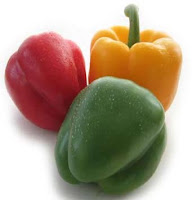Bell peppers (Capsicum annuum) are delicious vegetables that belong to the nightshade family of plants whose members include potatoes, tomatoes and eggplants..
They come in a variety of colors including yellow, green, orange, red, purple, brown and black. Green pepper belly is the most common in groceries and supermarkets. Other than their nutritional values and health benefits, pepper belly adds a brilliant splash of color and perfect texture to all dishes
How to prepare
Wash the pepper under cold running water before cutting it. In cases where the pepper has been waxed; usually done to protect it from pests and rodents, scrub it gently but thoroughly with a natural brush.
To make slicing easier the stem and seeds should be detached first. For stuffed pepper, cutting is not necessary.
Detaching of the stem can be done in two ways.
a) Cut half lengthwise and then cut out and discard stem, inner membrane and seeds.
b) Make circular cut with around top of pepper then pull stem from pepper; scoop out seeds and inner membrane.
Rinse pepper under running water to remove any excess seeds; drain well.
Slicing can be done into rings or strips. Remember to place the skin side down on the cutting surface. Thicker slices are preferable for diced(cubes: not very small pieces) while thinner are best for minced(cut into very small pieces)
a) For strips cut the pepper into halves the slice halves lengthwise into strips then cut across the strips to dice or mince
b) For rings thinly slice pepper crosswise
Finally gather the strips or rings and slice crosswise into desired pieces. In other words this is simply to mince or dice




















